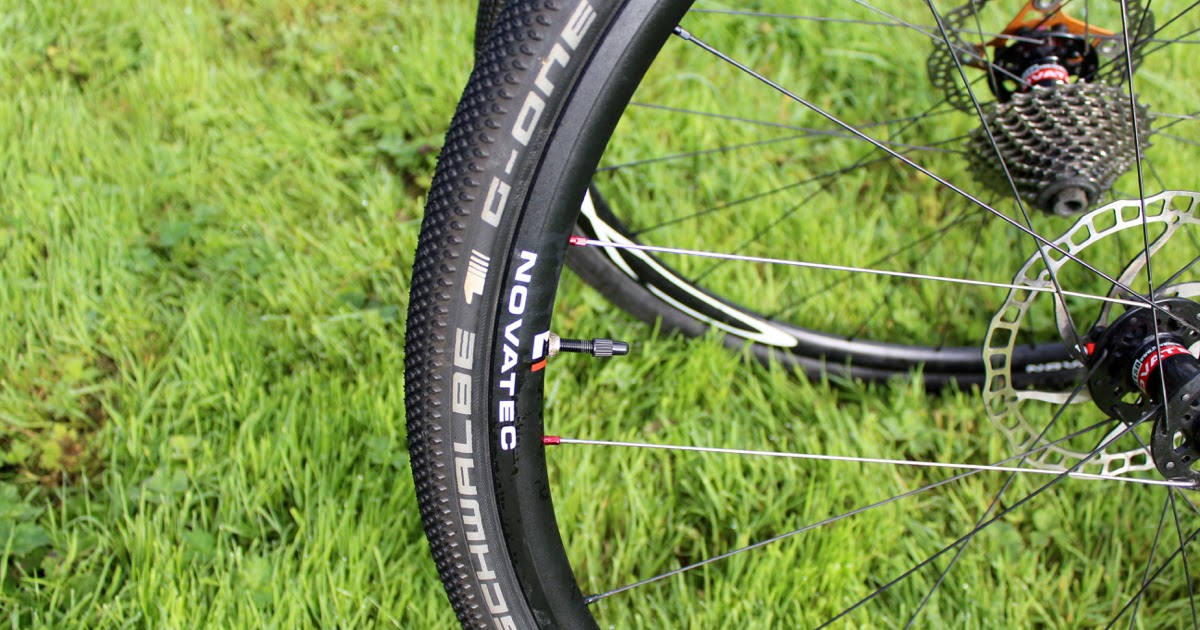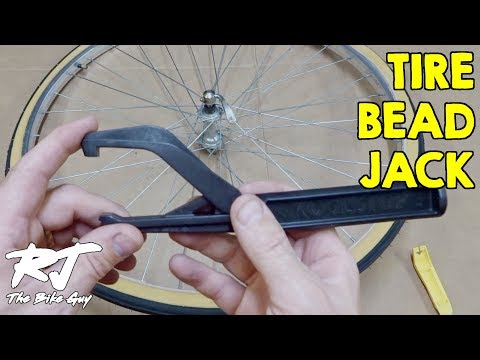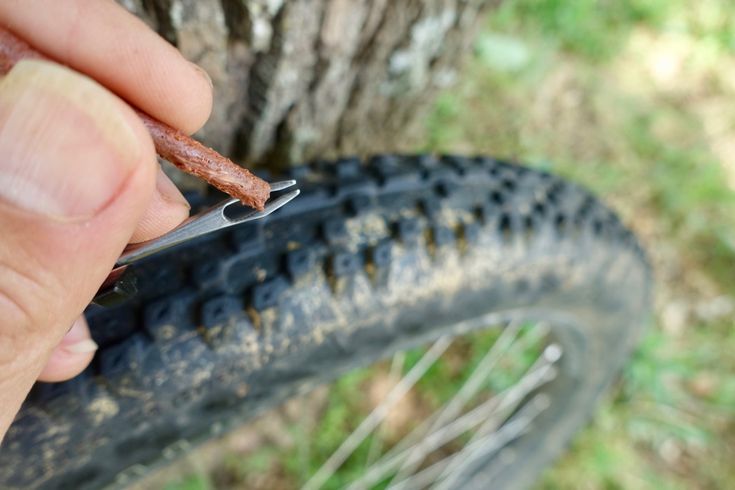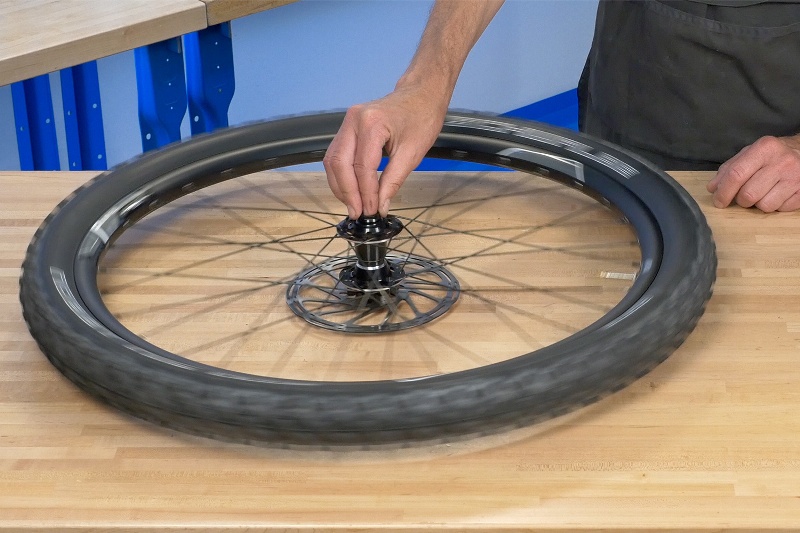1
What do I need to know how to do?
What Tools do I need?
First, verify that your components are tubeless compatible. See Tubeless Tire Compatibility for more information on tubeless tire standards.
3
There are two main methods for adding sealant to the tire:
This method requires a measuring cup. An air compressor is highly recommended.
This method requires a valve with a removable valve core, a syringe, and an air compressor.

Sealant seeping through the tire bead
The rim strip on this wheel was not adequately sealed. Sealant may, in time, create a seal
4
In general, punctures in tubeless tires cannot be repaired. Punctures in UST tubeless tires, and other tubeless tires with a butyl inner lining, can potentially be repaired using a vulcanizing patch kit such as the VP-1. It is not recommended that you attempt to use other types of patches, or attempt to repair other types of tubeless tires.
It is not recommended that you attempt to use other types of patches, or attempt to repair other types of tubeless tires.
See Inner Tube Repair for instructions on using a vulcanizing patch kit.
There are two main types of flat tires, a pinch flat and a puncture flat. Upgrading to tubeless tires helps to ward off both of these. A pinch flat occurs when the tube is pinched against the rim, usually the result of a hard impact or improper installation. With tubeless bike tires it’s simple: no tubes, no potential for pinch flats! Punctures meanwhile, like thorns, nails and the like will be sealed by the tubeless tire sealant, so you can keep riding. In the event of a puncture that the sealant can’t seal, you can always throw in a tube and keep riding. Dealing with fewer flat tires is one of the biggest advantages of tubeless tires.
More often than not, you will be able to shave some weight off of your bike by converting to tubeless tires. While the weight savings here aren’t huge, this is the most noticeable kind of weight to lose from your bike - rotational weight. In other words, there will be less weight for you to have to turn with every pedal stroke. This will let you accelerate more quickly, which is definitely noticeable when climbing hills, especially on more technical sections of mountain bike trails.
Another great benefit of tubeless bike tires is the ability to run lower tire pressures. Lower tire pressures give you greater traction on the road or trail, and gives your ride some more padding. Traditionally, lower pressures meant a greater risk of pinch flats, but as we discussed earlier, you don’t have to worry about pinch-flatting tubeless mountain bike tires.
Tubeless bike tires work by creating a seal between your bike tires and rims, meaning you don’t need inner tubes to keep air in your tires. The bead of the tire seats into the rim, then a gooey sealant product is inserted into the tire to make it airtight. Running tubeless tires gives you a host of benefits from fewer flats to reduced weight. While the initial setup of your tubeless mountain bike tires can be a little bit tricky, it’s a worthwhile upgrade to any bike.
The bead of the tire seats into the rim, then a gooey sealant product is inserted into the tire to make it airtight. Running tubeless tires gives you a host of benefits from fewer flats to reduced weight. While the initial setup of your tubeless mountain bike tires can be a little bit tricky, it’s a worthwhile upgrade to any bike.
This is evo. We are a ski, snowboard, wake, skate, bike, surf, camp and clothing online retailer with physical stores in Seattle, Portland, Denver, Salt Lake City, Whistler, Snoqualmie Pass, and Hood River. Our goal is to provide you with great information to make both your purchase and up-keep easy.
evo also likes to travel to remote places across the globe in search of world-class powder turns, epic waves, or legendary mountain biking locations through evoTrip Adventure Travel Trips. Or, if you prefer to travel on your own, check out our ski & snowboard resort travel guides, and mountain bike trail guides.
Still have questions? Please give our customer care team a call at 866-386-1590, Customer Care Hours. They can help you find the right setup to fit your needs.
Throughout the life of a bicycle, you will need to clean, lubricate and possibly repair various parts. If you ride often and like to diversify the route, then eventually one or both of your tires will wear out, and the chamber will be blown out more than once due to a puncture. Therefore, it is important to be able to repair the cut, as well as replace the tire and tube.
It won't take you long to learn. The main thing is to carefully and consistently follow the steps below. Trust me, changing tires or tubes is easy. nine0003
1. Turn bike upside down with wheels .
You can mount the bike in a dedicated repair stand or hang it with the frame securely fixed. The wheels should turn freely without any resistance.
The wheels should turn freely without any resistance.
It can be secured with nuts on an axle that needs to be loosened (usually a cheaper version of the bike). nine0003
Depending on the make of your bike, the wheel can also be secured with a quick-release lever (eccentric) that needs to be released. Also, there are mounting options directly on the axle, when the axle parts (hex bolts) are directly tightened and thus fix the wheel in the feathers. As a rule, such axles are quite wide, hollow inside and are installed on more expensive models of bicycles (most often mountain bikes).
If you have V-brakes (rim brakes), open the mechanism by releasing the springs. You can also loosen the cable, but you need to remember to fix it after reinstalling the wheel. This is done so that you can remove the wheel, since (when the brakes are working) the pads will hold the tire. nine0003
If you have disc brakes, you can remove the wheel without any additional steps.
3. Remove tire from the wheel rim.
Locate the nipple and select a location on the opposite side of the wheel. Using the bead (a tire removal tool that looks like a spoon, spatula), separate the tire from the wheel rim and fix the bead on the spoke. Repeat the procedure with the second bead at a distance of about 2.5 cm from the first. Continue doing this around the wheel until you can completely remove the tire. nine0003
Please note that if you need to seal or replace the inner tube, it is not necessary to completely remove the tire. It is enough to disassemble one side to get the camera. This will make the next process easier.
4. Check and clean the inside of the tire for debris.
Look for anything that could cause cuts or punctures. Specifically, spikes, glass shards, and metal shards. After all, often what cut the tire and / or pierced the chamber remains in the tire and can ruin it again. nine0003
nine0003
5. Find holes or cuts in the tire and tube .
To find punctures, you can inflate and submerge the tube in water, watching carefully for air bubbles. You can also do this without water, but only if the puncture is large enough. Otherwise, you simply will not hear where the air is leaking from.
If you clearly see a hole or a wide cut on these parts, then you will most likely need to purchase a new tire and tube. It will be possible to glue only with slight damage to the material. During a puncture, the tire does not need to be sealed at all, since it itself tends to shrink and not expand the hole. nine0003
6. For , glue the holes with repair kit .
Take a piece of sandpaper and sand the area around the puncture. It is also desirable to degrease it for better adhesion to the patch. Take a patch and, using glue, patch the puncture. Firmly press the patch and its edges, smooth with your fingers (the back of the screwdriver will work too).
Firmly press the patch and its edges, smooth with your fingers (the back of the screwdriver will work too).
7. Wait a few minutes for the adhesive to set .
Insert the tube into the wheel and inflate to the maximum possible pressure (the value is indicated on the tire). Thus, the tire will press the patch to the chamber, and the patch itself will finally stick to the stretched surface of the chamber, which is what we need. If this is not done, then the patch will dry to the tightened surface of the chamber and may peel off when inflated. When installing the camera, do not forget that it should “lie down” without kinks and twists.
8. W Replace tire if necessary.
If your goal is to replace a tire, then take apart the old one, remove it and take a new one. Insert one side of the new tire into the rim, and bolster the other side with the beads. Often, when installing a new tire, this action can be easily performed with your fingers, without the help of any tools. Make sure your tire fits into the rim, doesn't come out anywhere, and is evenly distributed. Pump up the wheel.
Often, when installing a new tire, this action can be easily performed with your fingers, without the help of any tools. Make sure your tire fits into the rim, doesn't come out anywhere, and is evenly distributed. Pump up the wheel.
9. Insert the wheel into the slots on the bike fork or stays.
Fasten the axle. Don't forget to fix the brakes!
That's it. We remind you that you can change tubes and tires in the workshop of the Goldenbike store. Stay with us!
06 Breast 2018, Thu
In this article, we'll show you how to fix a puncture or cut on a tubeless bike tire. What tools are needed for this. What mistakes should not be made when repairing bk rubber. nine0003
To repair punctures and cuts up to 2cm, you can use special tire repair kits. They are a screwdriver with a sharpener and a special hook for a tourniquet made of vulcanized rubber. In our store, such sets are represented by the Lezyne brand:
In our store, such sets are represented by the Lezyne brand:
1. So, we got a puncture or a cut in the tire. First you need to quickly find the puncture site and prepare a repair kit. nine0003
Important! It is advisable not to let the tire go down "to zero" as it can "snap out of the beads" (this is when the tire peels off the rim bead) and then, in addition to the puncture, you will also have to solve the problem with inflation in the field, and this requires a special Co2 pump or a high-performance pump/stack/compressor. So that the tire does not go down completely, you can not remove the object due to which the wheel has broken through or pinch the puncture site with your finger until you start to eliminate the puncture. nine0003
2. Prepare the site of damage to the tire: We remove the cause of the puncture from the wheel, if it remains, and insert the awl of the repair kit into the site of damage and grind it. We take out the awl and again hold the puncture site with your finger so that the wheel does not go down.
We take out the awl and again hold the puncture site with your finger so that the wheel does not go down.
3. Take the tourniquet and insert it into the holder as shown in the photo.
4. Together with the tourniquets, we insert our awl into the puncture site by about 1.5-2 cm so that two tendrils of the tourniquet stick out. Glue is not required. If there is sealant left in your tire, it will seal the remaining puncture well. If the sealant is not enough, it is advisable to add it, but after using the repair kit. nine0003
5. Now the most difficult moment, which everyone who has ever dealt with tire repair does in his own way, is how to remove the awl and at the same time leave the tourniquet in the tire. Someone simply breaks the tourniquet in half by twisting the awl in the tire (this is what many motorists or motorcyclists do), but for this you need to have a fairly strong tire with a thick bead. If the tire is light and thin, then this trick will not work.
Tip: In my experience, I stretch the tourniquet a little in the middle, thereby making it thinner at the awl grip. This allows you to easily remove the holder from the flagellum when it is already in the tire. nine0003
Q&A:
How reliable and durable is this repair? How wide can a hole be repaired with a repair kit?
- With proper use of the repair kit, this repair will last the entire life of the tire. An exception occurs only in cases where the cut is more than 1.5-2 cm or the tire at the place of the cut begins to "diverge along the seam".
Do I need to cut off the tendrils from the harness protruding from the tire?
Not required. Over time, they will rub against the asphalt because they have a softer rubber compound than your tire. nine0003
Can the repair kit be used in wet weather?
Yes. No problem.
Can an awl or a small screwdriver be used instead of a special awl-screwdriver for repairing tubeless tires?
- It is possible, but this carries with it certain nuances.